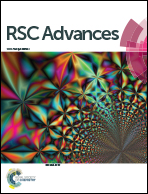A novel biosensor for silver(i) ion detection based on nanoporous gold and duplex-like DNA scaffolds with anionic intercalator†
Abstract
This study demonstrates a novel biosensor for silver(I) ion detection based on nanoporous gold (NPG) and duplex-like DNA scaffolds with anionic intercalator. The hairpin structure was formed initially through hybridization with the unlabeled probe (S1 + S2 + S3). In the presence of Ag+, the structure of immobilized DNA changed to duplex-like structure, and formed a C–Ag+–C complex at electrode surface. The response current of the modified electrode after immersing in the disodium anthraquinone-2,6-disulfonate (AQDS) as the signal agent was changed. And an increased current was obtained, corresponding to Ag+ concentration. NPG provided faster electron transfer and an excellent platform for DNA immobilization. Under optimal conditions, silver(I) ion could be detected in the range from 1 × 10−10 M to 1 × 10−6 M, and the lower detection limit of the biosensor for Ag+ is 4.8 × 10−11 M with good specificity. The results showed that this novel approach provided a reliable method for the quantification of Ag+ with sensitivity and specificity, which was potential for practical applications.


 Please wait while we load your content...
Please wait while we load your content...